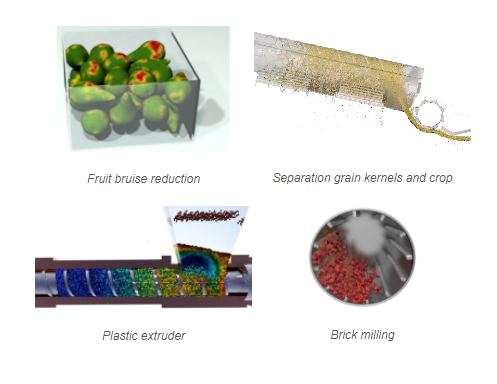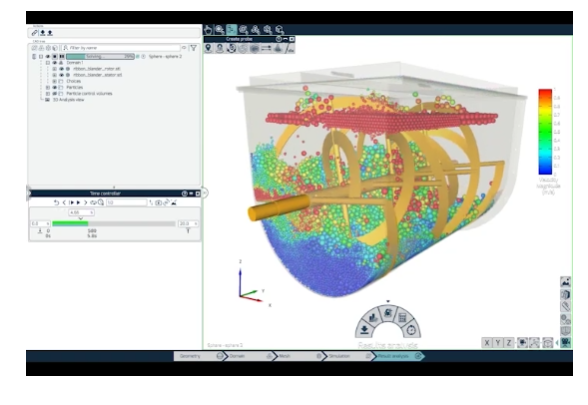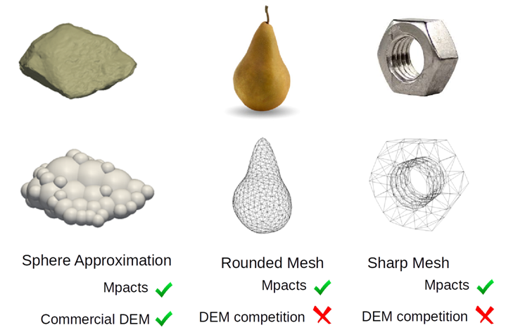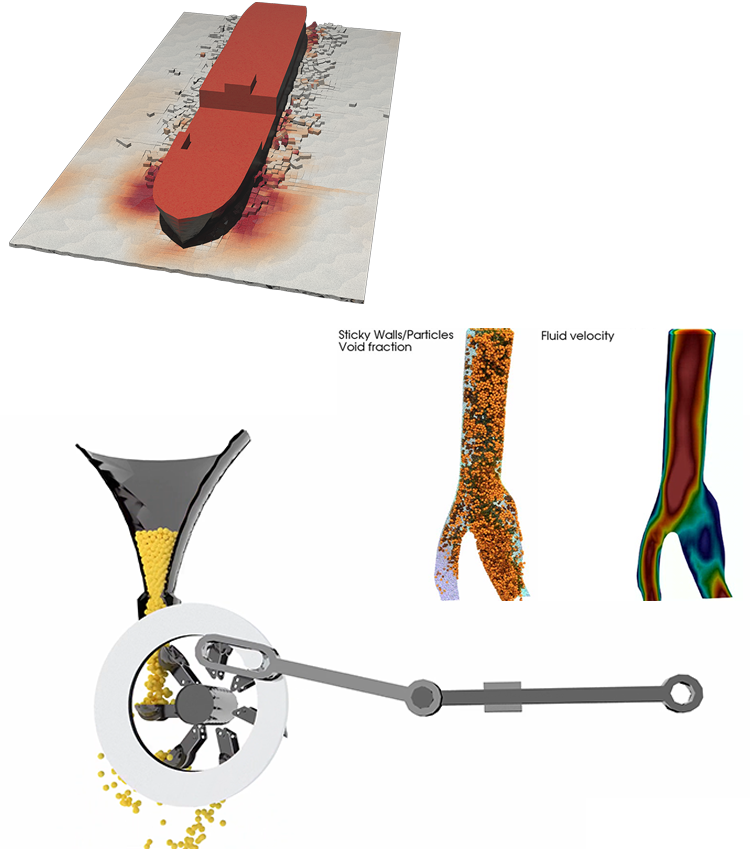Omnis™/Mpacts
Simulating particle dynamics with the Discrete Element Method (DEM)
Due to the discontinuous nature of granular materials, particle dynamics simulation requires a different solver approach compared to the classical Computational Fluid Dynamics (CFD). Particle simulation software Omnis™/Mpacts, helps designers of industrial processes understand, analyze, and solve the complex system properties of particle interactions without the need for experimental prototypes. Thanks to the Discrete Element Method the results are highly reliable while engineering time remains minimum.
Particle interaction in industrial processes
Around 80% of all industrial processes are estimated to deal with particulate materials and particle interactions.
Examples can be found in:
• Food processing: fruit bruise analysis, mixing and blending…
• Heavy equipment: conveyor belts, hoppers, dump truck…
• Agriculture equipment: combine harvesters, tractors, tillage…
• Pharmaceutical and biotech: tablet coating, powder spreading, fluidized bed…
• and many more sectors

Dedicated features and post-processing in Omnis™
Omnis/Mpacts combines the power of the advanced DEM solver Mpacts with the user-friendly Omnis interface and all its capabilities from the pre-processing to co/post-processing in one workflow.
Offering all the benefits of the Omnis platform:
• Straightforward setup of the mechanical motion
• Surface materials definition
• Particle classes definition in the tree interaction
• Interactive control volume definition
• Automatic generation of the particle contact laws
• Particle post-processing
• and much more

Discrete Element Method simulation (DEM)
The discrete element method works by explicitly computing all forces acting on individual particles that are described in a domain (there is no mesh). These forces are computed starting from geometrical information such as overlap and contact areas. Using a model, such as the Hertz model, contact forces are obtained. These forces are then integrated into new velocities and positions (see video to the left).
Compared to the Finite Element Method, the fundamental difference and advantage is that DEM does not need a subdivision of space. Particles are explicitly represented by their position, shape, and orientation.
This offers a huge flexibility in representing the shapes and interaction mechanics of the particles, leading to highly accurate and reliable simulations.
Not only spheres: multi-shaped particles

Primary DEM formulations assume particle shapes to be perfect spheres, as this method requires minimal computational effort. However, the ability to simulate multiple-shaped particles is essential to meeting industry requirements.
This is where Omnis/Mpacts offers another unique and significant advantage: it can represent all possible particle shapes, preserving their physical properties entirely. Spheres, cylinders, polyhedra, capsules, fibers, sheets, and vesicles; they are all available in both rigid and deformable forms.
Coming soon…
The Mpacts solver is integrated into Omnis version 5.1. This version is focused on mechanical agitation applications such as mixers, conveyor belts, dump trucks, screw conveyors, etc. Its integration is continuous and some of the expert features described below will be released in future versions.
Damage modeling
How a product gets damaged or why it breaks apart is often important to know for robust and high-quality production. Omnis/Mpacts therefore includes damage/breakage models that compute the onset and extent of damages. Custom damage/break models are also available for dedicated mechanisms.
CFD coupling
The study of fluid flows is essential for many industrial processes. A typical example is the simulation of the flow in an artery bifurcation for the biomedical industry. In this simulation, particle movement and collisions are performed using the DEM, while the fluid is simulated using CFD. Two-way coupling is performed. The particles influence the flow pattern: the flow will look for the ‘easiest’ path through the particle stacking, and through drag forces, the flow will also drive the motion of the particles.

Rigid-body coupling
Several parts of a machine are often mechanically linked with coupled motions. The coupling is usually done through rotational or translational constraints or a combination of both. The rigid-body functionality of Mpacts ensures a straightforward and smart definition of a coupled-motion machine, while maintaining high-speed simulations.
Key features
Features
• Arbitrary particle shapes
• Various material definition
• Numerous definition of solid mechanical motion
• Buoyancy
• Diverse particle contact interaction
• Dedicated particle post-processing
Modeling capabilities
• Packing/stacking simulation
• Mixing model
• Impact prediction
Main applications
• Powder mixers
• Crop flow in agricultural machines
• Soil tillage equipment
• Conveyor belts
Pars Makina From All Perspectives
Eco-Friendly
In all our projects that we carry out, we strive to use renewable energy sources and equally, we prefer to use recyclable materials.
Work Ethics
We add our motivation and ethical values to our continuous development efforts and we realize our projects through an evolving design that take into account feedbacks from numerous simulation and tests.
Safety
We always place safety the first place. We prioritize worker healthin all type of field works, factory production, assembly and tests carried out in our workshop.
Social Responsibility
Through the development of high and ınnovatıve technologies, we fulfil our duty regarding the development of our country and entire world wellness.
Advanced Technology
We always provide world-class engineering and production services with our R & D and production team that follows the technological state-of-the-art in our fields of expertise.
Customer Focused
We ensure customer satisfaction by providing efficient and reliable products that emanate from our responsible and positive-thinking attitude.
Look at Us More Closely
Pars Makina develops novel technological products that results from long term fundamental R&D studies. Our intellectual property contains many recent national and international patents that increase our worldwide competitiveness. For sustained growth of our capabilities and increased market share, we continue to produce state-of-the-art solutions involving high technologies. We also strive to work closely with national and international academic institutions and leading large companies in Turkey and Europe.
Pars Makina
We provide reliable, economical, high-power and efficient innovative solutions in the fields of Transport, Defence, Aerospace, Aerospace Engineering and Clean Energy.

